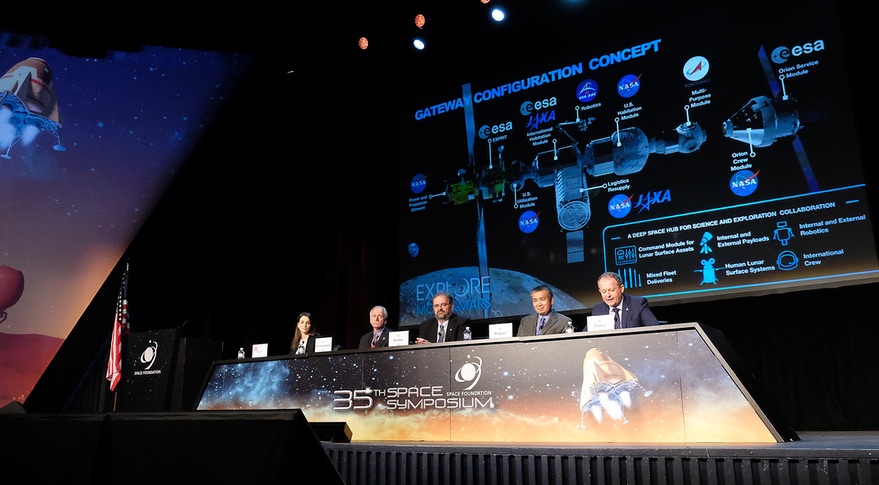NASA’s accelerated moon plans create uncertainty for international partners

NASA has yet to outline its approach to meeting the goal announced in a March 26 speech by Vice President Mike Pence of landing humans on the south pole of the moon within five years. The agency has been working internally on at least a high-level approach for doing so, and plans to start sharing details with the White House, including the Office of Management and Budget, this week in order to finalize a revised budget request that’s expected to seek several billion dollars more in fiscal year 2020 alone.
However, in comments at the 35th Space Symposium, NASA Administrator Jim Bridenstine said the agency would pursue a two-phase approach that would initially emphasize speed. That approach is expected to use the Space Launch System and Orion, lunar landers and some version of a lunar Gateway.
That lunar Gateway, though, will likely be a scaled-down version of earlier concepts publicized as recently as a month ago that featured a suite of habitation, utilization and other modules provided by NASA and other current International Space Station modules. Some concepts under consideration require only the Power and Propulsion Element, which NASA is in the process of procuring, along with a docking node of some kind that could also serve as a habitation module.
Publicly, potential Gateway partners have said little about how NASA’s accelerated approach would affect their ability or willingness to participate. During an April 10 panel session here on exploration, officials from NASA, the Canadian Space Agency, European Space Agency and Japan Aerospace Exploration Agency largely avoided direct discussion of what NASA’s new plans would mean for international contributions to the Gateway or other elements of the exploration architecture.
“We’re now taking the plans that we have in place and seeing how we can accelerate those,” said Bill Gerstenmaier, NASA associate administrator for human exploration and operations. “The good thing is that we’re going to show and prove that the architecture we’ve laid out, the plans we’ve put in place, are adaptable and we’ll be able to continue to move forward.”
David Parker, director of human and robotic exploration at ESA, emphasized that the Gateway is intended to be “flexible and sustainable” amid any changes. “It’s flexible in the way that it evolves and grows over time.”
Privately, though, international partners expressed concerns about how the accelerated plans could affect their schedule or ability to contribute to the overall exploration effort by delaying or even eliminating contributions like Gateway modules. This is an issue in particular among ESA member states, as the agency works to win approval for its role in the exploration program at a ministerial meeting in November in Spain.
It also raises questions in Canada, where the government of Prime Minister Justin Trudeau announced its plans to invest more than two billion Canadian dollars into development of a robotic arm for the Gateway less than a month before Pence announced the new goal for landing humans on the moon. Canada was the first country, other than the United States, to formally sign on to the Gateway program.
Bridenstine said he’s aware of those worries. “It has been a concern to our international partners, and they have expressed that to me throughout this conference,” he said in a briefing with reporters here April 9.
He said he’s told international partners that the two-phase approach, which will shift to a more sustainable long-term effort after the 2024 landing, will still provide opportunities for international partners. He added there may also be cases where partners like ESA, which produces the Orion service module, could be asked to do more in the near term. “We’re not abandoning them. In fact, we could be asking more from them,” he argued.
Bridenstine said he’s aware that partner space agencies need to convince their governments to participate in the program, a challenge potentially made more difficult by NASA’s change in plans. “They have to get political buy-in from their legislatures,” he said. “What I’m making sure we do is we’re going to communicate how important these international partnerships are and that the new agenda doesn’t in any way change that.”
Asked specifically if Europe would have “complete clarity” on the new plans by this fall, Bridenstine said that would be the case. “I told them I’d be happy to make a trip out to Europe in order to give their political leadership the assurances necessary that our goals have not changed,” he said, citing language in Space Policy Directive 1 calling for a sustainable return to the moon with international partners. “I am happy to fly out to Europe and meet with the political leadership to give them assurances that this is still on the agenda.”
“The 2024 humans to the surface of the moon [goal] does not in any way abandon our international partnerships,” he continued. “We need and we want international partnerships.”
ONGC Graduate Trainee Engineering Various Post Online Form 2019





